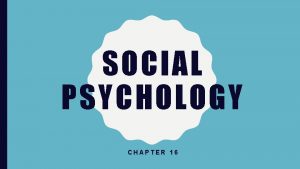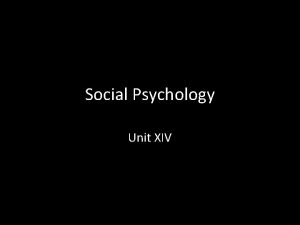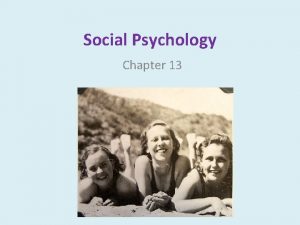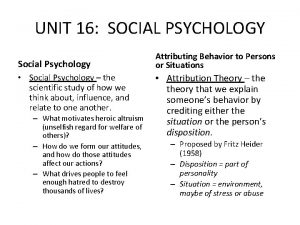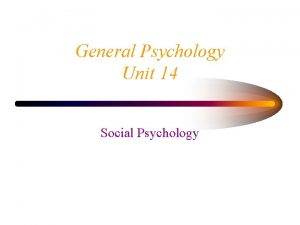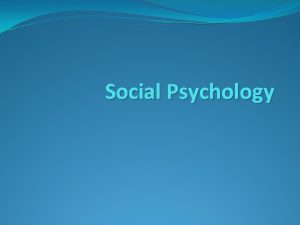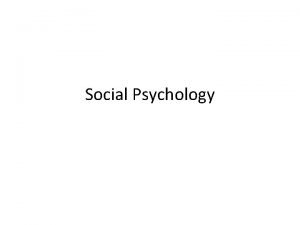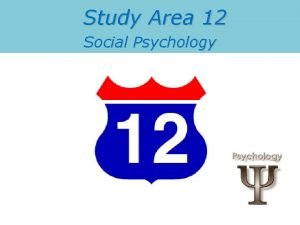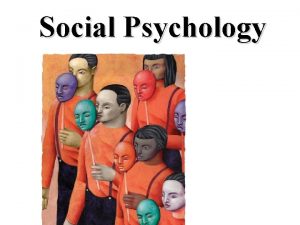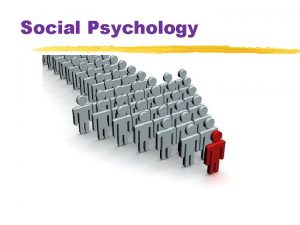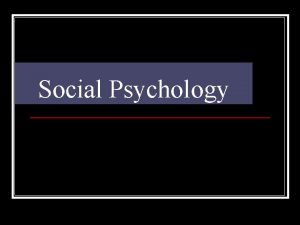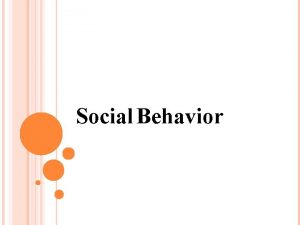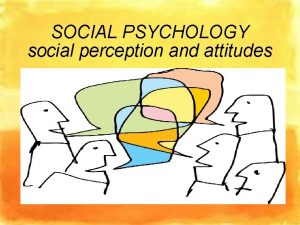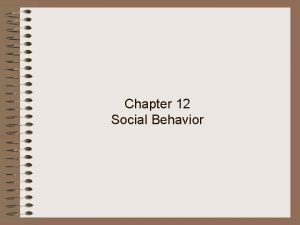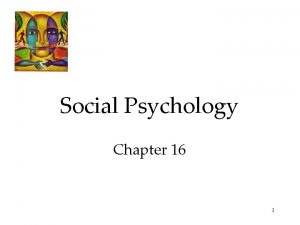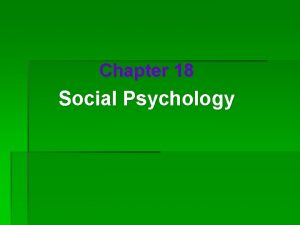SOCIAL PSYCHOLOGY AP Psychology Social Psychology The study















































- Slides: 47

SOCIAL PSYCHOLOGY AP Psychology

Social Psychology • The study of how we think about, influence, and relate to one another. • 3 Themes • • • Social thinking - how we think about others. Social influence - how we are influenced by others. Social relations - how we relate to and interact with others.

SOCIAL THINKING Attributions Attitudes

Attribution Theory • Fritz Heider - 1958 • Suggests how we explain someone’s behavior – by attributing it to either the situation or the person’s disposition • • • Situation = environmental, external attribution Personal disposition = personality, internal attribution A teacher notices that one of her students is particularly hostile. • • Aggressive personality (internal attribution) Reaction to stress or abuse (external attribution)

Examples • Mom yelled at me today. ☹ • • • Internal attribution External attribution I bought mint chocolate chip ice cream today! • • Internal attribution External attribution

Examples • Mom yelled at me today. ☹ • Internal attribution • • External attribution • • Mom enjoys yelling at me. Mom had a bad day at work. I bought mint chocolate chip ice cream today! • Internal attribution • • I reallllllly like mint chocolate chip ice cream. External attribution I was told mint chocolate chip ice cream is popular these days, therefore I should get it because it’s cool. • I’m hungry. (though biologically based, it’s a situational action). * •

Attribution Theory and Politics • Poverty in America • Conservative perspective - internal attribution • • People live in poverty because they are lazy and less motivated than others – something about their inherent disposition contributes to their status. Liberal perspective - external attribution • People live in poverty because their life circumstances have resulted in an unfortunate situation – something about their environment contributes to their status.

Fundamental Attribution Error • The tendency to underestimate the impact of the situation and to overestimate the impact of personal disposition when trying to explain another person’s behaviors. • • Juliet is shy in class. Observing this, we naturally think that she is a shy person -- it is an aspect of her personality. Catch her at a party and she might seem like a completely different person. On the flip side… we often attribute OUR OWN behaviors to external factors, while downplaying internal factors. • I’m being rude because I’ve had a bad day, not because I’m a rude person. • Actor: attribute to situation/environmental factors • Observer Bias: will attribute to internal factors*

The Effects of Attribution • Our attempt to attribute others’ behaviors to certain things can have real consequences. • • • Our attributions can change depending on our emotions AND the context. • • Jury deciding whether a shooting was malicious or in self-defense. Manager evaluating the poor performance of an employee. A spouse makes a snippy remark. In an unhappy marriage, the remark could be attributed to that spouses’ personality. In a happy marriage, the remark could be attributed to that spouse having a bad day at work. Bottom line: Our attributions – to individuals’ dispositions or to their situations – have real consequences.

Attitudes • Feelings based on our beliefs that influence our reactions and responses to people, objects, and events. • Ex: If we believe someone is mean, we may feel dislike for the person, and act unfriendly. Attitudes Behavior s

Attitudes Affecting Behaviors • We typically think in terms of attitudes affecting actions (common sense view). • Changing attitudes can change behaviors… how can attitudes be changed? • Central route to persuasion – persuasion method that attempts to change attitudes by appealing to actual facts about the message • • • Salesperson tries to persuade your attitudes about buying a car by focusing on the gas mileage, the tire durability, and safety features. Requires more critical thinking and attention BUT has a greater likelihood of long-term attitude change. Peripheral route to persuasion – persuasion method that attempts to change attitudes by appealing to peripheral cues (aspects apart from the central idea or message) • Salesperson tries to persuade your attitudes about buying a car by using a celebrity endorsement*

Attitudes Affecting Behaviors Central Route Peripheral Route

Behaviors Affecting Attitudes • Foot-in-door phenomenon – the tendency to agree to a small request at first, then to a larger request later • • Start small and build Doing (actions) becomes believing (attitudes) • Consent to “safe driver” small sign then to large, ugly sign later • An example of this is when you ask your mom to borrow a small amount of money, then later asks to borrow a larger amount.

Other Similar Phenomena • Often taught in business school as sales/negotiation strategies • Door in face technique - start with a big request that you know will be refused, then offer a “concession” smaller request • • Saying “no” to a large request may make the person feel they owe the other person who made the request a favor. Low-ball technique - agreeing to an initial request, and then when it increases, you still agree to it because you feel bad about backing out. • When the request changes or becomes unreasonable, the person will (to a degree) find it difficult to say “no” because of having originally committed themselves.

Behaviors Affecting Attitudes • Role-playing – the tendency to strive to be the role that is assumed Behaviors feel phony at first, but then real. • finding ways to justify • • Zimbardo’s Stanford Prison Experiment (6 days!), 1971 • Abu Ghraib Prison in Iraq, 2004

Behaviors Affecting Attitudes • Cognitive dissonance - the feeling of discomfort that results from holding conflicting beliefs; leads to a change in attitude to reduce the dissonance. • The more dissonance (tension/discomfort) we feel, the more motivated we are to change attitudes to justify the prevailing attitude or behavior. • We want internal consistency. • more effective to change behavior first, then attitude will follow. Behavior • Smoking • Produces cognitive dissonanc e Attitude 1 • Smoking is harmful to my health. Crash Course – Social Thinking Attitude 2 • I enjoy smoking. Resolution • Change attitudes. • “I exercise daily so the effects are lessened. ”

Consider a situation in which a man who places a value on being environmentally responsible just purchased a new car that he later discovers does not get great gas mileage. The conflict: It is important for the man to take care of the environment. He is driving a car that is not environmentally friendly. In order to reduce this dissonance between belief and behavior, he can sell the car and purchase another one that gets better gas mileage, or he can reduce his emphasis on environmental responsibility. In the case of the second option, his dissonance could be further minimized by engaging in actions that reduce the impact of driving a gas-guzzling vehicle, such as utilizing public transportation more frequently or riding his bike to work.

SOCIAL INFLUENCE Conformity Obedience

Conformity • Adjusting behavior or thinking to coincide with a group standard • Behavior is contagious. • Chameleon effect – mimicking others’ behaviors • Mood linkage – mimicking others’ emotions

Conformity • Solomon Asch (1955) asked participants to judge line lengths, when most confederates would answer wrong, the participant would go along with it more than 1/3 of the time • Participant experienced cognitive dissonance resulting from the conflicting beliefs/attitudes.

When to Conform • Feelings of incompetence or insecurity • 3+ people present • Unanimous consensus within group • Group’s status or attractiveness is desirable • No prior commitment to any response • Others in the group observe one’s behavior

Why Conform? Normative Social Influence • Conforming to gain social approval or avoid social rejection • Informational Social Influence • Looking to others to get approval/avoid disapproval Conforming due to uncertainty about how to act/think • Looking to others for information on what to do • Giving a standing ovation at a concert because if you don’t, you’ll receive judgmental looks • Giving a standing ovation at a concert because you are unsure if you should, but you see others do it. • Asch Experiment: Conforming to the wrong answers of others because you want social approval of the group. • Asch Experiment: Conforming to the wrong answers of others because you are genuinely unsure if you are correct.

Obedience • Complying to social pressures and authority Milgram’s Obedience Experiments (1963, 1974) • • • Paired teacher and learner; the learner received a “shock” for every wrong answer; shocks increased in intensity as questions continued. 63% (of 40 in the original experiment) completed the shock hierarchy. Participants experienced cognitive dissonance.

Obedience • Why continue to shock? • • Presence of authority figures Prestigious institutions Depersonalization and distance of victims No role models for defiance

Obedience • “The most fundamental lesson of our study is that ordinary people, simply doing their jobs, and without any particular hostility on their part, can become agents in a terrible destructive process…” • • • Milgram Foot-in-door-phenomenon Cognitive dissonance Behavior • “I was • Attitude 1 only following orders. ” Attitude 2 Resolution Adolf Eichmann, Director of Nazi deportation of Jews to concentration camps • Shocking • Hurting • other People also have free others will. in people bad. • Obedienc e to authority is good. • Change attitudes. • “I’m just or following to orders. ” Producesline: When considering to conform/not conform • • Bottom cognitive obey/disobey, consider the context and the consequences. dissonanc e

GROUP INFLUENCE Individuals in groups social facilitation social loafing deindividuation Groups as a whole group polarization groupthink

Social Influence – Individuals in Groups Social facilitation Social loafing Definition Example Stronger responses on tasks in the presence of others • Competing against the clock vs other people Others = arousal • Good at task→ better performance • Bad at task→ worse performance • Remember Yerkes-Dodson Law • Leaving a green light faster when other cars are present Tendency to slack off in a group setting when attaining a common goal • Tug of war • Freeloaders Others = decreased effort in groups Deindividuation Losing individual identity and thought when in a group Possible when group members feel aroused (+/-) and anonymous → lose selfconsciousness and respond to the group experience. • Riots/mobs • Masks/Tribal paint • KKK, gang members • Crowds at sports games

Social Influence – Groups as a Whole Definition Example Group polarization Strengthening and enhancement of a • Political party conventions group’s ideas, thoughts, tendencies through • internet chat rooms, blogs discussion in the group • when high prejudiced people “Preaching to the choir” discussed racial prejudice with each other, they became more prejudiced. Groupthink Thinking or make decisions as a group while overriding realistic alternatives • Considering few alternatives • Selective gathering of information Group polarization leads to increased partisanship (bias) in politics. Belief that WMDs were in Iraq early 2000 s Successful avoidance of groupthink was demonstrated in “World War Z” → The Tenth Man (has the duty to disagree with the majority)

The Power of the Individual • Minority influence – the power of 1 or 2 individuals to sway a majority Difficult but influential • Must be consistent • Blue-Green Study Crash Course – Social Influence

SOCIAL RELATIONS Prejudice Aggression Conflict Attraction Altruism Peacemaking

Prejudice • A negative, unjustifiable attitude toward a group and its members. • • Stereotyped beliefs Negative feelings/emotions Discriminatory actions Prejudices = schemas for perceiving and reacting to events and people

Prejudice, Racial Profiling, and Attribution Theory • After Hurricane Katrina, residents began to search for food and supplies in abandoned stores and houses. The media attributed these actions to different reasons based on race and prejudices. • Black Americans – “looting, ” attributed to racial stereotypes that were believed inherent • White Americans – “finding, ” attributed to situational circumstances

Causes of Prejudice • Social • • • Inequalities Have vs. have-nots Haves rationalize their position above the have nots Ex: Segregationists in CRM

Causes of Prejudice • US • • vs THEM Ingroup – “us” – people with whom one shares a common identity Outgroup – “them” – those perceived as different/not like you and your group • Ingroup • bias – the tendency to favor one’s own group Ex: cliques in HS, nations at war, sports fans • Distinctions • can be made arbitrarily and still have power. Blue vs. Brown Eyes experiment in the 1960 s.

Causes of Prejudice • Scapegoating • theory that prejudice offers an outlet for anger by providing someone to blame • Blaming as an outlet for anger, confusion, or frustration • Ex: 9/11 and discrimination against innocent Arab Americans and Muslims • Ex: Hitler and persecution of Jews

Causes of Prejudice • Just-world phenomenon - the tendency to believe the world is just/fair and that people therefore get what they deserve and deserve what they get. • Good is rewarded, evil is punished → those who are rewarded must be good? Those who suffer must be bad? • • Ex: When neighbors of Nazi concentration camps were confronted with the actual purpose of the camps (even though most people knew), many rationalized the treatment by saying, “What terrible people must have been kept here. ” Implications for approaching poverty, prison reform, etc. • Dark Knight, The Joker’s Social Experiment Crash Course – Prejudice and Discrimination

Aggression ● Physical or verbal behavior intended to hurt or destroy Nature • Brain – amygdala (stimulation – aggression) • Damage to the frontal lobe • Blood chemistry – hormones, alcohol • Males tend to be more aggressive Nurture • Operant conditioning – learned behavior through reinforcement • Observational learning – Bandura’s bobo doll experiment

2 Main Types of Aggression Hostile Aggression Instrumental Aggression • Aggression stemming from feelings of anger and aimed at inflicting pain • Aggression that serves as a means to some goal other than causing pain. • Frustration-aggression principle – reacting to aversive events in an aggressive manner • Ex: stealing a toy because you want to play with it, tackling the ball carrier, self-defensive actions • Ex: bullying, trashing a locker room because you lost a game

Conflict • A perceived incompatibility of actions, goals, or ideas • Social trap - situation in which an individual experiences a conflict, then acts to obtain short-term individual gains, which eventually leads in the long run to a loss for the group. • Pits our own self-interests against society's well-being. • People often rationalize their self-serving tendencies in various ways. Ex: During heat waves in large cities, many people will over-use power for AC, leading to power blackouts. → Rationalize by making an excuse for why they needed the AC. • Ex: A person doesn’t recycle certain waste which leads to overfilling of landfills. → Rationalize with the excuse that just one person not recycling is not that big of a deal. •

Peacemaking • Cooperation through superordinate goals - shared goals that override differences among people and require their cooperation. • Working toward shared goals allows diverse peoples to discover their commonalities and shared values. • Ex: teacher could pair conflicting students together to complete a project, hopefully the students would overcome some of their differences • Ex: bipartisan political groups

Attraction • Proximity – geographic nearness/closeness → increased interactions • • Technology has changed the meaning of “proximity” Familiarity breeds fondness. • Mere-exposure effect - the phenomenon that repeated exposure to novel stimuli increases liking of them Ex: i. Phone’s reversible camera and “selfies” – preferring the mirror image vs reverse • Ex: Companies bet that the more you see/are exposed to their product, the more likely you are to buy it. •

Attraction • Physical attractiveness • • • Evolutionary • • • More likely to be perceived as healthy, happy, and socially skilled Prefer symmetry and average features Masculine/dominant/ mature men Youthful/healthy women Cultural • “Beauty is in the eye of the beholder” – reflects time and place

Attraction • Similarity breeds content Opposites do not attract • Friends and couples often share common interests, attitudes, beliefs, age, religion, race, education, intelligence, smoking behaviors and economic status. • • Reward theory of attraction - we will like those whose behavior is rewarding to us and we will continue relationships that offer more rewards than costs.

Types of Love Passionate Love • • Companionate Love an aroused state of intense positive absorption in another, usually present at the beginning of a love relationship Two-factor theory of emotion Arousal Romanti c Appraisal Passion • the deep affectionate attachment we feel for those with whom our lives are intertwined • Adaptive?

• Kitty Genovese and attacker → stabbed to death in 1964 while neighbors heard her cries and did nothing to help. Altruism unselfish regard for the welfare of others Notice? Emergency? Responsibility ? The Presence of Others • bystander effect - the tendency for any given bystander to be less likely to give aid if other bystanders are present. • Reflects social loafing → diffusion of responsibility

We are more likely to help if… The victim… • Appears to need and deserve help • • • Similarity breeds content Have just observed someone else being helpful • Just-world phenomenon Is in some way similar to us • We… Informational social influence? • Are not in a hurry • Are in a small town or rural area • Less deindividuation • Feel guilty • Are not preoccupied • Are in a good mood • Feel-good-do-good phenomenon

Why do we help others? Term In other words… Example Social exchange theory - Rewards of interaction social behavior is an -- Costs of interaction exchange process that If profitable = behavior aims to maximize benefits and minimize costs Giving money to the homeless so you feel like you have been altruistic, but only to the point where it isn’t financially harmful. Social-responsibility Help those that norm - an expectation that ask/seem to people can and should need/deserve help people who depend upon them Giving directions to someone who asks. Reciprocity norm – the expectation to respond to a positive action with another positive action “I’ll scratch your back if you scratch mine. ” Help those who have helped you. Social-responsibility norm – Subway Hero Reciprocity norm – Gift giving
 Social psychology is the scientific study of
Social psychology is the scientific study of Module 74: attribution, attitudes, and actions
Module 74: attribution, attitudes, and actions Hình ảnh bộ gõ cơ thể búng tay
Hình ảnh bộ gõ cơ thể búng tay Ng-html
Ng-html Bổ thể
Bổ thể Tỉ lệ cơ thể trẻ em
Tỉ lệ cơ thể trẻ em Voi kéo gỗ như thế nào
Voi kéo gỗ như thế nào Chụp phim tư thế worms-breton
Chụp phim tư thế worms-breton Alleluia hat len nguoi oi
Alleluia hat len nguoi oi Các môn thể thao bắt đầu bằng tiếng bóng
Các môn thể thao bắt đầu bằng tiếng bóng Thế nào là hệ số cao nhất
Thế nào là hệ số cao nhất Các châu lục và đại dương trên thế giới
Các châu lục và đại dương trên thế giới Cong thức tính động năng
Cong thức tính động năng Trời xanh đây là của chúng ta thể thơ
Trời xanh đây là của chúng ta thể thơ Mật thư anh em như thể tay chân
Mật thư anh em như thể tay chân 101012 bằng
101012 bằng độ dài liên kết
độ dài liên kết Các châu lục và đại dương trên thế giới
Các châu lục và đại dương trên thế giới Thơ thất ngôn tứ tuyệt đường luật
Thơ thất ngôn tứ tuyệt đường luật Quá trình desamine hóa có thể tạo ra
Quá trình desamine hóa có thể tạo ra Một số thể thơ truyền thống
Một số thể thơ truyền thống Cái miệng nó xinh thế
Cái miệng nó xinh thế Vẽ hình chiếu vuông góc của vật thể sau
Vẽ hình chiếu vuông góc của vật thể sau Thế nào là sự mỏi cơ
Thế nào là sự mỏi cơ đặc điểm cơ thể của người tối cổ
đặc điểm cơ thể của người tối cổ V. c c
V. c c Vẽ hình chiếu đứng bằng cạnh của vật thể
Vẽ hình chiếu đứng bằng cạnh của vật thể Tia chieu sa te
Tia chieu sa te Thẻ vin
Thẻ vin đại từ thay thế
đại từ thay thế điện thế nghỉ
điện thế nghỉ Tư thế ngồi viết
Tư thế ngồi viết Diễn thế sinh thái là
Diễn thế sinh thái là Dot
Dot Bảng số nguyên tố lớn hơn 1000
Bảng số nguyên tố lớn hơn 1000 Tư thế ngồi viết
Tư thế ngồi viết Lời thề hippocrates
Lời thề hippocrates Thiếu nhi thế giới liên hoan
Thiếu nhi thế giới liên hoan ưu thế lai là gì
ưu thế lai là gì Hổ đẻ mỗi lứa mấy con
Hổ đẻ mỗi lứa mấy con Sự nuôi và dạy con của hổ
Sự nuôi và dạy con của hổ Hệ hô hấp
Hệ hô hấp Từ ngữ thể hiện lòng nhân hậu
Từ ngữ thể hiện lòng nhân hậu Thế nào là mạng điện lắp đặt kiểu nổi
Thế nào là mạng điện lắp đặt kiểu nổi Social traps ap psychology definition
Social traps ap psychology definition Social psychology ap psychology
Social psychology ap psychology Social thinking and social influence
Social thinking and social influence Social thinking adalah
Social thinking adalah

















































